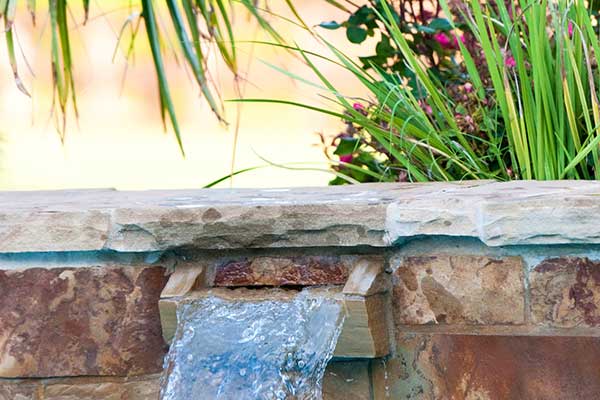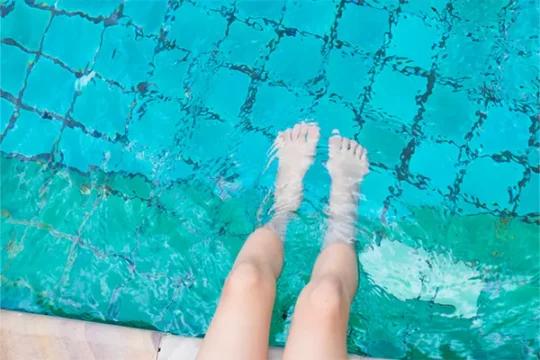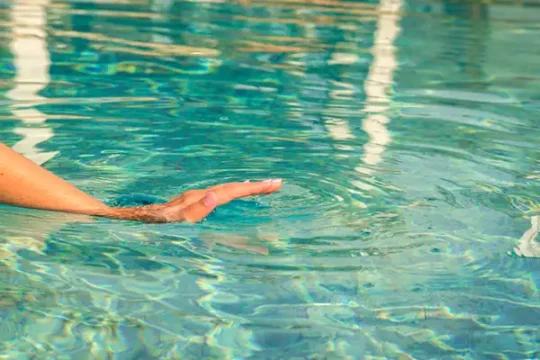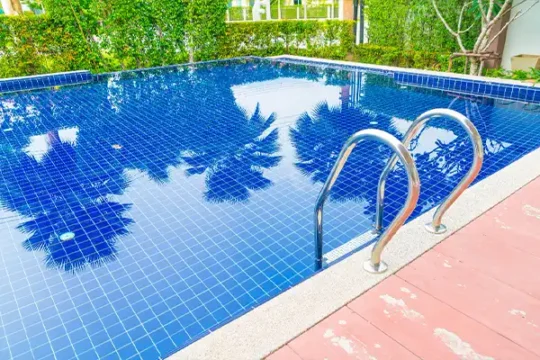TABLE OF CONTENTS
A visit to natural falls is often the highlight of any trip. Artificial waterfalls can make the difference between a ho-hum experience and something unforgettable, whether you encounter them in a restaurant, a front yard, or next to a well-built backyard pool.
You’re probably thinking about adding a waterfall feature to your inground pool, which led you to this page. Let’s discuss all the key details of pool waterfalls, so you can decide whether you should build one, what you can expect if you do… and why you might want to think twice before building that extra-elaborate waterfall you’ve been dreaming about.
What Is A Pool Waterfall?
An artificial waterfall connected to a swimming pool is sometimes called a grotto. The terms are usually interchangeable. All functional pool waterfalls share several common features and functions:
- A pool waterfall starts above the pool’s waterline
- Water flows over the “fall” through powered pumps
- Any functional waterfall will need some extra maintenance
Pool waterfalls come in a wide range of shapes, sizes, and designs, and can be constructed with natural materials (like some convenient local rocks) or artificial materials, typically concrete, bricks, or synthetic structures. Some builders can install pre-formed waterfalls made from molded concrete. You might even find plastic waterfall structures if you look hard enough — but we wouldn’t recommend it!
Artificial waterfalls use powered pumps to pull water up to the top level, or spillway, of a waterfall structure. Some waterfalls can be built into the upper lip of the pool, roughly at ground level, making their “structure” part of the pool itself. Others flow from raised walls or more extensively designed structures overlooking the pool.
No matter how they’re designed, all functional pool waterfalls need pumps to move water upwards against the pull of gravity. No pump, no waterfall.
Waterfalls can be integrated into elevated tanning ledges or spas as well. Integrated waterfalls might sacrifice some natural aesthetics, but they often provide more functionality than a natural stone waterfall. You’ll see some examples of integrated waterfalls further in this article. You can create a “natural” design around a functional waterfall as well, but this will typically cost more than placing pump systems in the right places on pool designs with different elevations.
What Are The Benefits Of Pool Waterfalls?
You know pool waterfalls can look fantastic. But did you know they can also make you feel fantastic? The sound of gently rushing water can be calming and therapeutic — there’s a reason so many “go to sleep” soundtracks include the sound of waterfalls or ocean tides. Here are some key benefits of a pool waterfall:
- Aesthetics
- Therapeutic value (calming sound and visuals)
- Can block background noises when operating
- Water circulation (adds several related benefits)
- Cooling effects (in hot climates)
- Can enhance filtration and reduce algae build-up
- Can increase play area (when properly designed)
- May add value to your home (compared to a waterfall-less pool)
The sound of an active waterfall can also muffle less enjoyable background noises, like nearby traffic, the hum of running pool equipment, and various annoying birds and insects. If you’re prone to overthinking, the sound of your pool waterfall can help you turn down that inner monologue and just relax.
The pumps keeping water moving over your waterfall ledge(s) have functional benefits, too. Your primary pool filter uses pumps to circulate water through its mechanisms, which traps gunk and prevents stagnant water from fouling the pool.
A waterfall can connect to your filtration system or be used to augment it, adding extra circulation and sweeping more gunk out of your way before it becomes a problem. Flowing water takes longer to heat up than calm, flat water, so many pool owners use waterfall features to moderate heat build-up during the dog days of summer.
Falling water can also oxygenate your pool, which works with the movement of the water itself to reduce harmful particles and prevent algae growth. This won’t replace your primary filtration system, but it can extend its lifespan and allow you to reduce your use of chemical treatments.
Larger pool waterfall installations can also be used to hide equipment and machinery. You might even install entertainment features, like lighting and sound systems, to create an instant party in your backyard oasis. However, the cost of a pool waterfall will rise quickly as you add more functionality (and height and/or decoration) to its design.
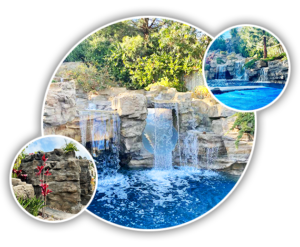
Want an Artificial Rock Waterfall? Let’s talk!
At Tropical Rocks, We are leaders in the restoration and repair of artificial rocks, making your space something exclusive and natural.
We have a specialized team that works hard and in a timely manner to provide you with our guaranteed seal of comfort and luxury.
With over 20 years of experience in artificial rock pool installation and repair, we provide our customers with top-of-the-line services and a wide range of designs for your artificial rock pool so that your sweet home can stand out from everyone else’s in the neighborhood.
So, what are you waiting for? Pick up your phone and call us now at 949-691-3845 to book a valuable consultation.

